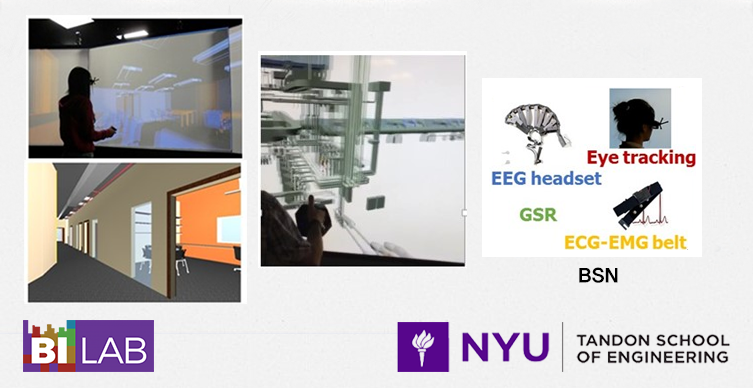 The impact of built environment on the human responsiveness and performance has long been argued; however, the interrelations between neuroscience and built environment, and the degree to which the built environment contributes to increased human performance and context awareness has not been completely understood yet. Towards this understanding,this project is at the intersection of Neuroscience and Architecture to quantify the impact of architectural design features on human performance and experience. This project utilizes advanced visualization, virtual reality and body area sensor networks to capture human bodily states while people interact with architectural layouts in virtual settings.
The impact of built environment on the human responsiveness and performance has long been argued; however, the interrelations between neuroscience and built environment, and the degree to which the built environment contributes to increased human performance and context awareness has not been completely understood yet. Towards this understanding,this project is at the intersection of Neuroscience and Architecture to quantify the impact of architectural design features on human performance and experience. This project utilizes advanced visualization, virtual reality and body area sensor networks to capture human bodily states while people interact with architectural layouts in virtual settings.
Zou, Z., Yu, X., and Ergan, S. (2019). “Integrating biometric sensors, VR, and machine learning to classify EEG signals in alternative architecture designs.”ASCE International Conference on Computing in Civil Engineering. June 17 – 19, 2019. Atlanta, Georgia, U.S.
Zou, Z., and Ergan, S. (2019). “Where do we look? An eye-tracking study of architectural features in building design.” Advances in Informatics and Computing in Civil and Construction Engineering (pp. 439-446). Springer, Cham. https://doi.org/10.1007/978-3-030-00220-6_52.
Zou, Z., and Ergan, S. (2019). “A framework towards quantifying human restorativeness in virtual built environments.” EDRA 50: Sustainable Urban Environments: Research, Design and Planning for the Next 50 Years. May 22 – May 26, 2019. Brooklyn, New York, U.S.
Ergan, S., Radwan, A., Zou, Z., Tseng, H. A., and Han, X. (2018). “Quantifying human experience in architectural spaces with integrated virtual reality and body sensor networks.” Journal of Computing in Civil Engineering, 33(2),04018062. https://doi.org/10.1061/(ASCE)CP.1943-5487.0000812
Ergan, S., Shi, Z., and Yu, X. (2018). “Towards quantifying human experience in the built environment: A crowdsourcing based experiment to identify influential architectural design features.” Elsevier Journal of Building Engineering, 20(11), 51-59. DOI: https://doi.org/10.1016/j.jobe.2018.07.004.
Zou, Z., Arruda, L., and Ergan, S. (2018). “Characteristics of models that impact transformation of BIMs to virtual environments to support facility management operations.” Journal of Civil Engineering and Management, 24(6), 481-498. https://doi.org/10.3846/jcem.2018.5689.
Zou, Z., and Ergan, S.(2018). “Human experience in stimulating architectural spaces: integrating VR and body sensor networks.” ANFA Academy of Neuroscience for Architecture Annual Conference, (poster presentation), La Jolla, CA, September 20-22, 2018.
Radwan, A., and Ergan, S. (2017). “Quantifying human experience in interior architectural spaces.” International Workshop of Computing in Civil Engineering, June 25-27, 2017, Seattle, WA, pp. 373-380. DOI:https://doi.org/10.1061/9780784480830.046.
Radwan, A., and Ergan, S. (2016). “Towards quantifying the impact of the built environment on human experience: elements of experimental design.” ANFA Academy of Neuroscience for Architecture Annual Conference, (poster presentation), La Jolla, CA, September 23-24, 2016.